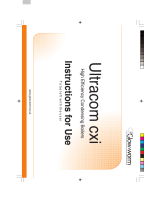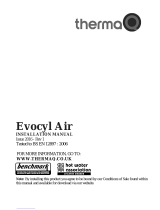
5
IMPORTANT:
Where no British Standards exists, materials and equipment
should be t for their purpose and of suitable quality and
workmanship.
The installation of this product must be carried out by a
competent person in accordance the rules in force in the
countries of destination.
Manufacturer’s instructions must not be taken as overriding
statutory requirements.
Statutory Requirements
In GB, the installation of the product must be carried out by a
competent person as described in the following regulations:
The manufacturer’s instructions supplied.
The Gas Safety (Installation and Use) Regulations.
The appropriate Buildings Regulations either The Building
Regulations, The Building Regulations (Scotland),The
Building Regulations (Northern Ireland).
The Water Fittings Regulations or Water byelaws in Scotland.
The Health and Safety at Work Act, Control of Substances
Hazardous to Health (COSHH).
The Current I.E.E. Wiring Regulations.
Where no specic instructions are given, reference should be
made to the relevant British Standard Code of Practice.
In IE, the installation must be carried out by a competent
person and installed in accordance with the current edition
of I.S.813 “Domestic Gas Installations”, the current Building
Regulations and reference should be made to the current
ETCI rules for Electrical Installation.
GB: the following Codes of Practice apply:
BS4814, BS6798, BS5440 Part 1 and 2, BS5546 Part 1,
BS5449, BS6891, BS6700, BS7074 Part 1 and 2, BS7593,
BS7671.
IE: I.S.813, BS5546, BS 5449, BS 7074, BS 7593.
NOTE: For further information, see the current issue of the
Building Regulations, approved document L1 ( in the UK) and
the following current issues of:
1) Central heating system specication (CheSS)
and
2) Controls for domestic central heating system and hot water.
BRECSU.
Statutory Requirements
Domestic Hot Water
All domestic hot water circuits, connections, ttings must be
in accordance with the relevant standards and water supply
regulations.
GB: Guidance G17 to G24 and recommendation R17 to R24
of the Water Regulations Guide.
IE: The current edition of I.S.813 “Domestic Gas Installations”.
Heating System
In GB, it is necessary to comply with the Water Supply (Water
Fittings) Regulations 1999 (for Scotland, the Water Byelaws
2000, Scotland).
To comply with the Water regulations your attention is drawn
to: The Water Regulations guide published by the Water
Regulations Advisory Service (WRAS) gives full details of the
requirements.
In IE, the requirements given in the current edition of I.S.813
“Domestic Gas Installations” and the current Building
Regulations must be followed.
Solar cylinder and cylinder installation
Pressure equipment directive 97/23/EC Directive of the
European Parliament and Council from 29th May, 1997 for
the approximation of the laws on pressure equipment of the
Member States
EN 12977-3 Thermal solar systems and components; Custom
built systems, Part 3: Performance characterisation of stores
for solar heating systems
EN 12897 Water supply - specication for indirectly heated
unvented (closed) storage water heaters
EN 806-1 Specications for installations inside buildings
conveying water for human consumption - Part 1: General
EN 1717 Protection against pollution of potable water
installations and general requirements of devices to prevent
pollution by backow
EN 60335-2-21 Safety of household and similar electrical
appliances; Part 2: Particular requirements for storage water
heaters (hot water cylinders and hot water boilers) (IEC 335-
2-21: 1989 and supplements 1; 1990 and 2; 1990, modied)
Regulations in Great Britain
Building Regulation, dating from 1991 (England and Wales)
Requirement G3, L1 and Regulation 7
BS 7671 Requirements for electrical installations (IEE Wiring
Regulations, 16th edition)
BS 6759-1 Directive for the usage of the safety assembly for
hot water cylinders






















